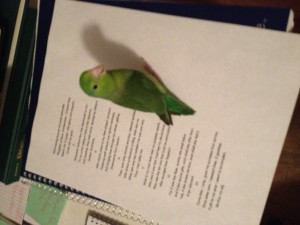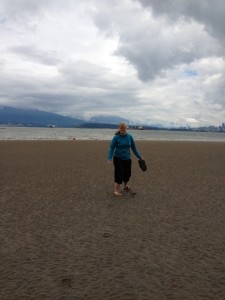It was late. Armageddon22 was three hours late for work in his part of the world. Daisyswillrerise was three hours late for bed. Godschosenwitness was missing school. RedRoversOnPluto had nothing better to be doing. Jumpindon’tlook was bored one morning. So, “Jump” logged in to an online chat-she’d heard that might be fun from a friend, and wanted to try it.
(Who knows if any of these anonymous pseudonyms is male or female or something less socially definable, but since language doesn’t really seem to have evolved to support story telling without the use of gendered pronouns, let’s alternate, and think of them as the meaningless place holders they are.)
Anyway, back to Jump, who clicked around chat groups, insulated communities of all shapes and sizes, no definable location or segregation, except for their closed off attitude, their exclusive interest in one topic or area of life, imposing societal boundaries on a medium that could theoretically work just fine without them. Then, he found them. A group who seemed to be having fun, telling scary stories, like they were sitting around an exclusively anonymous global campfire. They were faceless, but distinctive. Colour Jump intrigued. She clicked “Join”.
Seconds later, accepted without reservation, he was thrown into an insanely competitive universe, a contest to scare one or other of their group off the internet for the night/day/moment, where ever they really were. They were all in the now, the moment, the relativistic present that was different for every one of them, and would be the past when the future arrived seconds later. Their activity lists, liked books, favourite movies, friends lists, user pics, and archived chats were so different, there was no relation between any of them.
Daisy was quiet, liked books and music and shades of pink and mauve and baking, a stereotype to fit with the first part of her pseudonym, on which an ironic pale was cast by the rest of her choice.
Armaggedon liked guns, heavy metal, and the good ol’US of ‘A-another stereotype, edged in shades of green.
RedRover liked space and red, Godschosen liked bible verses and church groups.
Are they having me on?, thought Jump. Is anyone really this one dimensionally stereotypical?
Still, Jump being no coward, he jumped right in to compete. The challenges got wilder and wilder-ghost stories, disaster stories, retold horror movies, invented horror movies, grisly tales of horror and death that left violent nightmares in their wake.
Jump was somehow being pulled into a world he wasn’t prepared for, something outside of his ordinary existence, something wild and untamed and crazy. She was loving every terrifying minute.
Then, it was suddenly his turn to present the ultimate challenge to the group. Everyone else had presented spine chilling tales, each out competing the last. This was it. Go big or go home, in or out. Win or lose. Jump had no intention of losing.
War. Hate. Horror.Supernatural insanity. Murderous terror.Friendly fire, terrorism, government corruption, corporate rot and disease, murder, mayhem, atrocities untold. Images, words, videos, pictures.
Jump had never mentioned she was a world class hacker. He could spin anything to look like anything, weave a story of imagination with threads of truth to create a narrative unparalleled in its believable depravity.
She pressed post, simultaneously broadcasting it. The response was cacophonous. Horror, disgust, outrage-no. Admiration, respect, awe-yes. But also, fear, worry, even terror.
Everyone agreed Jump had won unequivocally. RedRover, however, suggested he might have gone a bit far.
Daisy said “more than a bit not good there man.”
Armageddon forwarded him a link about Pandora’s box, with the tagline “might want to not leave that post up, as brilliant as it was.”
Godschosen said “we don’t need more pain in the world. Delete it, and be grateful we’re online where you can do that sort of thing; take back something you’ll regret.”
Jump “listened” politely, and then drew their attention to a live news feed on the edge of the blog.
They hadn’t known Jump was a hacker, and a very good one. They also hadn’t known Jump hated to lose, at anything.
The post had gone viral, sent to every major network on the planet simultaneously. With one click of a button, the world exploded into chaos and evil incarnate, all because of one story.
Jump posted one last time, before blinking out of existence like she’d never been there at all, “Next time, remember that in the modern world, nothing can ever really be deleted or taken back. Once it’s loose, once it’s out there, once a story has been told, it’s out there forever, and it can never be called back, never be taken back. Think before you type next time.”
I told this story to my brother and some of my friends, all of whom quite like stories about hacking and internet conspiracies. I discovered a couple things. First, they were astonished to find that this story was “taken” from another source with such a different setting, but still conveyed the same message, or attempted to.
Second, everyone I shared it with wanted to know exact details about what the story of horror was. In fact, the most intriguing aspect of the story for everyone seemed to be the level of suspense and horror it shows. Like horror films, the story awakened a primal thirst for violence and chaos in the people hearing it. Well, that’s one theory anyway.
My brother thought it was a cautionary tale, like a didactic poem from the 19th century, warning against the dangers of social media and hacking. My friends were intrigued by the ending, spending quite a while trying to come up with an explanation for who or what Jump was, and whether the ending was an elaborate hoax, a government trap, or what really happened.
I also discovered upon telling this by heart, that it was far too wordy to remember everything(I’d written it down first before memorizing it), and that it changed quite a bit in my verbal retelling-originally, Jump was the innocent party, not the hacker. Also, my listeners suggested additions and subtractions(there were two other characters originally, and Armageddon worked for the FBI). Also, as you may have noticed, mirror inconsistencies in the continuity of the narrative showed up as I told it(nobody left the internet after Jump won). I left them in for authenticity’s sake.
In the verbal retelling, I found hidden depths to both versions of the story. By retelling it both in person and online, I found myself thinking about the differences between oral and written stories once again, and the blurring of the lines between the two due to the internet. After all, as Jump said, social media gives us a far greater opportunity to circulate stories, and makes it all but impossible to call those stories back once they’re out there.
Works Cited:
King, Stephen. “Why We Crave Horror Movies.” American Culture and the Media. (1981): 504-508. Web. May 29, 2014.
“Pandora’s Box.” Myths and Legends. E2BN, 2006. Web. May 29, 2014.

